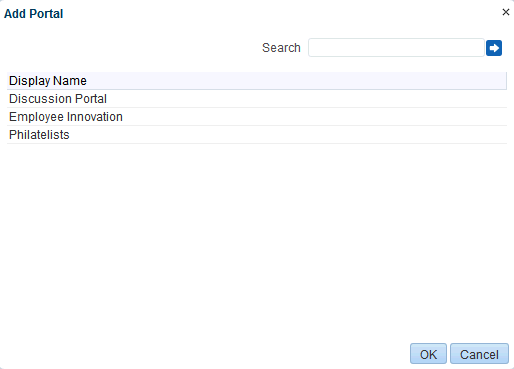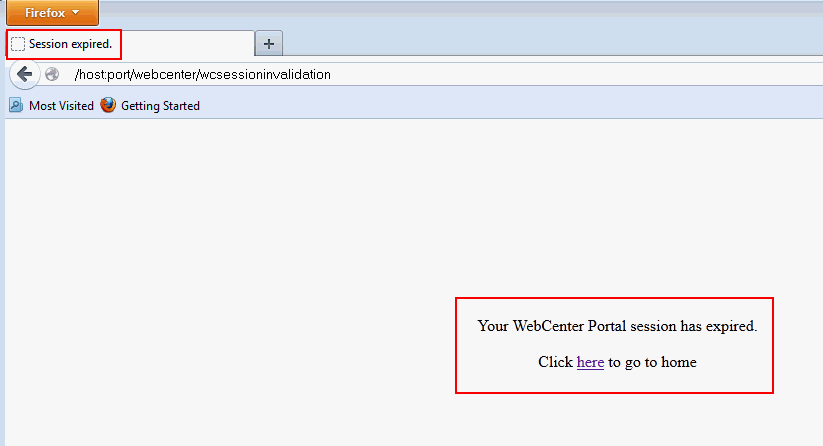48 Configuring Global Defaults Across Portals
This chapter describes the tasks available on the General page in WebCenter Portal Builder administration (Figure 48-1). The system administrator can modify the default settings to suit the needs of the organization.
This chapter includes the following topics:
-
Section 48.6, "Customizing Copyright and Privacy Statements"
-
Section 48.12, "Choosing a Default Look and Feel for New Pages"
-
Section 48.13, "Enabling and Disabling Access to the Home Portal"
-
Section 48.14, "Setting Up Defaults for WebCenter Portal Tools and Services"
Permissions:
To perform the tasks in this chapter, you must have the WebCenter Portal Administrator role or a custom role that grants the following permission:
-
Portal Server-Manage Configuration
Additionally, you need permissions to create and manage portals (Portals-Create and/or Portals-Manage All). For more information about permissions, see Section 49.3, "About Application Roles and Permissions."
Figure 48-1 Portal Builder Administration: General Page
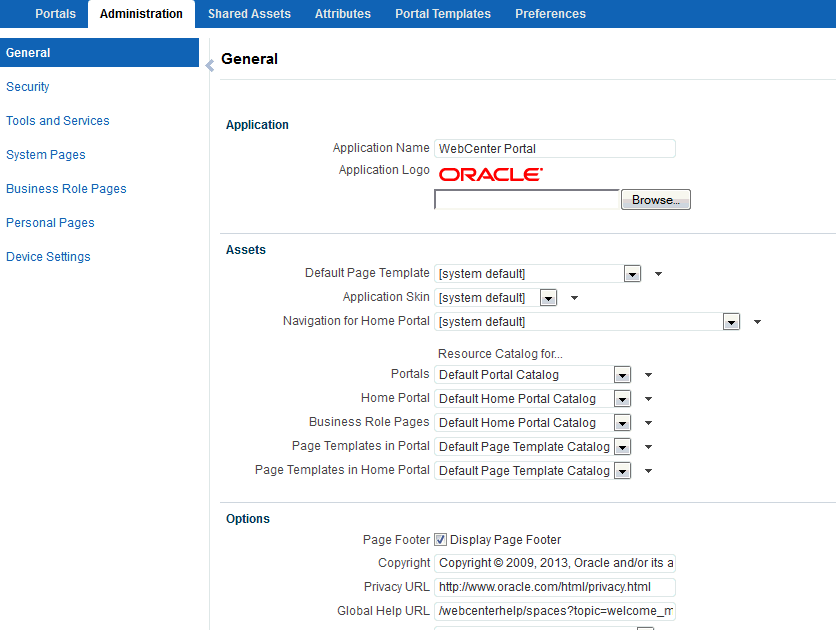
Description of "Figure 48-1 Portal Builder Administration: General Page"
48.1 Customizing the Name and Logo
Out-of-the-box, the Oracle logo and application name WebCenter Portal appear in the banner of all portals (Figure 48-2). You can change both the logo and name to better suit your target audience. For example, you might want to display your company name here or the name of a department within your company.
The logo you specify will resize according to the application's page template. If you want to adjust the logo size, you can modify the page template. See the "Editing a Page Template" section in Oracle Fusion Middleware Building Portals with Oracle WebCenter Portal.
Figure 48-2 WebCenter Portal Name and Logo
Description of "Figure 48-2 WebCenter Portal Name and Logo"
To change the name or logo for WebCenter Portal:
-
On the Administration page (see Section 47.2, "Accessing the Portal Builder Administration Page"), click General.
You can also enter the following URL in your browser to navigate directly to the General page:
http://host:port/webcenter/portal/builder/administration/general
See Also:
"WebCenter Portal Pretty URLs" appendix in Oracle Fusion Middleware Building Portals with Oracle WebCenter Portal.
-
In the Application Name field, enter the new name (Figure 48-3).
Alphanumeric characters are allowed and also portals, underscores (_) and dashes (-). For example,
Finance Department - My Corporation.Figure 48-3 Customizing the Application Name and Logo

Description of "Figure 48-3 Customizing the Application Name and Logo"
-
To change the logo, click Browse next to the Application Logo field.
-
In the File Upload dialog, navigate to the logo you want to use.
The logo image file can be up to 150 KB. Supported file formats are
.gifor.GIF,.pngor.PNG, and.jpgor.JPG. If the file is not uploading, check the size of the file you are trying to upload. The file name must contain alphanumeric characters only.The logo is uploaded to WebCenter Portal's image directory (
/webcenter/images) and the new logo immediately appears in the top left corner of the application banner. -
Click Save.
48.2 Choosing a Default Page Template
In WebCenter Portal, page templates define how individual pages and groups of pages display on a user's screen. Every page displays within a page template. System administrators can define the default page template used to display pages in the following places:
-
The Home portal
-
New portals, when the portal's template does not specify that a particular page template must be used
Portal moderators can override the default selection within their portal, but users cannot override the page template applied to the Home portal.
The Default Page Template for a device group can now also be overridden from Device Settings in WebCenter Portal Administration. Select the appropriate Device Group, then select Edit from the Actions drop-down list. Select the default page template from the Assets section for use with devices of the selected group.
Each page template works together with a skin to determine the overall look and feel of the pages in a portal. While the page template controls the location and behavior of components on the page, the skin controls the visual appearance of those components, such as the colors, fonts, and various other aspects.
See Also:
For more information about skins, see the "Working with Skins" chapter in Oracle Fusion Middleware Building Portals with Oracle WebCenter Portal.
Each page template can define a preferred skin to identify the skin that works best with that page template. When the page template is selected as the default page template for a portal or as the system default, the default skin automatically updates to the page template's preferred skin.
See Also:
For more information, see the "Setting a Page Template's Preferred Skin" section in Oracle Fusion Middleware Building Portals with Oracle WebCenter Portal.
See also the "Working with Page Templates" section in Oracle Fusion Middleware Building Portals with Oracle WebCenter Portal.
To select the default page template for WebCenter Portal:
-
On the Administration page (see Section 47.2, "Accessing the Portal Builder Administration Page"), click General.
You can also enter the following URL in your browser to navigate directly to the General page:
http://host:port/webcenter/portal/builder/administration/general
See Also:
"WebCenter Portal Pretty URLs" appendix in Oracle Fusion Middleware Building Portals with Oracle WebCenter Portal.
-
Do one of the following:
-
Select a Default Page Template from the available list (Figure 48-4).
To learn how to add page templates to this list, see the "Publishing or Hiding a Page Template" section in Oracle Fusion Middleware Building Portals with Oracle WebCenter Portal.
Figure 48-4 Selecting a Default Page Template

Description of "Figure 48-4 Selecting a Default Page Template"
-
Click the Advanced Edit Options icon, then select Expression Builder to enter an EL expression that determines the default page template dynamically based on certain criteria. If you need EL assistance, an application developer can provide an EL expression; see the "Expression Language Expressions" appendix in Oracle Fusion Middleware Developing Portals with Oracle WebCenter Portal and Oracle JDeveloper.
For example, you may like the default page template to change depending on which department or organization the logged in user belongs to.
-
-
Click Save.
48.3 Choosing a Default Skin
As a system administrator, you may customize the default appearance of WebCenter Portal for all users by changing the default skin. A skin changes the way the user interface appears, but does not change the application's behavior. See Section 48.3.1, "Applying a Skin for WebCenter Portal."
Users can override the default skin selection through user preferences. However, skins are often created for use with a specific page template. The choice of skin must therefore be compatible with the selected page template. For more information, see the "Changing the Look and Feel of Your View" section in Oracle Fusion Middleware Using Oracle WebCenter Portal.
If none of the built-in skins suit your requirements or you want to apply a look and feel that reflects your corporate brand, you can create and apply your own ADF skins. For your own page templates, you can note the preferred skin by setting (select Shared Assets, then copy a Page Template and select Edit Properties from the Actions drop-down list) the custom attribute preferredSkin to the skin family ID value of the skin that is preferred for use with a given page template. Doing this will allow the skin to switch to the preferred skin when your page template is chosen. If the page template is changed, then the skin will be updated (if it is not set to an expression) to match the page template. For more information, see the "Creating a Skin" section in Oracle Fusion Middleware Building Portals with Oracle WebCenter Portal.
The Default Skin for a device group can now also be overridden from Device Settings in WebCenter Portal Administration. Select the appropriate Device Group, then select Edit from the Actions drop-down list. Select the default skin from the Assets section for use with devices of the selected group.
If you want, you can reference the default skin in EL expressions. If you need EL assistance, an application developer can provide an EL expression; see the "Expression Language Expressions" appendix in Oracle Fusion Middleware Developing Portals with Oracle WebCenter Portal and Oracle JDeveloper.
Individual users can change the skin applied to their Home portal view through user preferences if they do not like the default skin that you specify. See the "Setting the Default Skin for a Portal" section in Oracle Fusion Middleware Building Portals with Oracle WebCenter Portal.
48.3.1 Applying a Skin for WebCenter Portal
When you set a skin for WebCenter Portal, the skin is applied to the Home portal and all portals that use the application-level skin setting. The skin is also applied to any new portals that are created.
To apply a skin to WebCenter Portal:
-
On the Administration page (see Section 47.2, "Accessing the Portal Builder Administration Page"), click General.
You can also enter the following URL in your browser to navigate directly to the General page:
http://host:port/webcenter/portal/builder/administration/general
See Also:
"WebCenter Portal Pretty URLs" appendix in Oracle Fusion Middleware Building Portals with Oracle WebCenter Portal.
-
Do one of the following:
-
Select an application skin from the available list (Figure 48-5).
Note:
If the desired skin does not appear in the Application Skin list, it may be because its Available option has been deselected. For information, see the "Managing a Skin" section in Oracle Fusion Middleware Building Portals with Oracle WebCenter Portal.
Each page template can define a preferred skin to identify the skin that works best with that page template. When a page template is selected as the new default page template for a portal or as the system default, the default skin automatically updates to the page template's preferred skin.
See Also:
For more information, see the "Setting a Page Template's Preferred Skin" section in Oracle Fusion Middleware Building Portals with Oracle WebCenter Portal.
WARNING:
changing the default skin to something other than the preferred skin for the selected default page template may produce unexpected results.
Figure 48-5 Applying a Skin to WebCenter Portal

Description of "Figure 48-5 Applying a Skin to WebCenter Portal"
-
Click the Advanced Edit Options icon, then select Expression Builder to enter an EL expression that determines the default application skin dynamically based on certain criteria.
For example, you may like the default skin to change depending on which department or organization the logged in user belongs to.
-
-
Click Save.
The skin you select is applied to WebCenter Portal, any new portals that are created, and all portals that use the application-level skin setting. The skin is not applied to the portals that override the application-level skin setting.
48.4 Choosing a Default Navigation
In WebCenter Portal, navigation models allow users to see and navigate to information quickly and easily. System administrators can specify which navigation to use for presenting Home portal information.
Alternatively, you can enter an EL expression that determines the navigation dynamically based on certain criteria. If you need EL assistance, an application developer can provide an EL expression; see the "Expression Language Expressions" appendix in Oracle Fusion Middleware Developing Portals with Oracle WebCenter Portal and Oracle JDeveloper. For example, you may like to display different navigations depending on which department or organization the logged in user belongs to.
See also the "Working with Navigations" chapter in Oracle Fusion Middleware Building Portals with Oracle WebCenter Portal.
To select a navigation model for the Home portal:
-
On the Administration page (see Section 47.2, "Accessing the Portal Builder Administration Page"), click General.
You can also enter the following URL in your browser to navigate directly to the General page:
http://host:port/webcenter/portal/builder/administration/general
See Also:
"WebCenter Portal Pretty URLs" appendix in Oracle Fusion Middleware Building Portals with Oracle WebCenter Portal.
-
Do one of the following:
-
Select a Navigation for Home Portal from the available list (Figure 48-6).
To learn how to add navigations to this list, see the "Showing and Hiding Portal Assets" section in Oracle Fusion Middleware Building Portals with Oracle WebCenter Portal.
Figure 48-6 Selecting a Navigation for Home Portal

Description of "Figure 48-6 Selecting a Navigation for Home Portal"
-
Click the Advanced Edit Options icon, then select Expression Builder to enter an EL expression that determines the navigation dynamically based on certain criteria. If you need EL assistance, an application developer can provide an EL expression; see the "Expression Language Expressions" appendix in Oracle Fusion Middleware Developing Portals with Oracle WebCenter Portal and Oracle JDeveloper.
-
-
Click Save.
48.5 Choosing Default Resource Catalogs
In WebCenter Portal, a series of Resource Catalogs display when you edit a page or a page template in Composer and click Add Content. Each catalog presents available resources in a series of folders and subfolders and the content changes dynamically depending on which services are currently available and the permissions of the person who is editing the page or page template. Available resources include task flows, portlets, and page components, such as images, content boxes, hyperlinks, and the like.WebCenter Portal provides several default resource catalogs out-of-the-box, but you can add new task flows, remove task flows, or reorganize the folder hierarchy to better suit your audience or create brand new ones of your own. For details, see the "Working with Resource Catalogs" chapter in Oracle Fusion Middleware Building Portals with Oracle WebCenter Portal.
System administrators can specify default page catalogs for:
-
New portals
-
Home portal
-
Business role pages
As well as, default page template catalogs for:
-
New portals
-
Home portal
It is entirely up to you whether you specify a different catalog for each scenario or use the same catalog throughout.
To select default resource catalogs for WebCenter Portal:
-
On the Administration page (see Section 47.2, "Accessing the Portal Builder Administration Page"), click General.
You can also enter the following URL in your browser to navigate directly to the General page:
http://host:port/webcenter/portal/builder/administration/general
See Also:
"WebCenter Portal Pretty URLs" appendix in Oracle Fusion Middleware Building Portals with Oracle WebCenter Portal.
-
In the Assets section, select default resource catalogs for the following (Figure 48-7):
-
Portals
-
Home portal
-
Business Role Pages
-
Page Templates in Portal
-
Page Templates in Home portal
To learn how to add resource catalogs to this list, see the "Showing and Hiding Portal Assets" section in Oracle Fusion Middleware Building Portals with Oracle WebCenter Portal.
Figure 48-7 Selecting Resource Catalogs for Assets
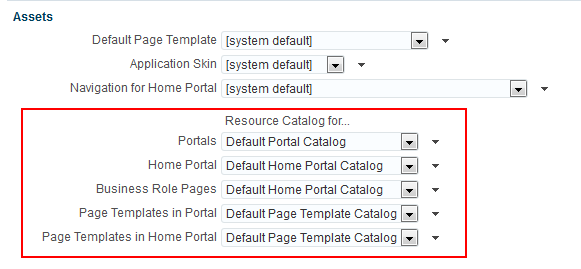
Description of "Figure 48-7 Selecting Resource Catalogs for Assets"
-
-
Optionally, click the Advanced Edit Options icon, then select Expression Builder to enter an EL expression that determines the default resource catalog dynamically based on certain criteria. For example, you may like the default resource catalog to change depending on the which role the logged in user belongs to. If you need EL assistance, an application developer can provide an EL expression; see the "Expression Language Expressions" appendix in Oracle Fusion Middleware Developing Portals with Oracle WebCenter Portal and Oracle JDeveloper.
-
Click Save.
48.6 Customizing Copyright and Privacy Statements
System administrators can customize or hide copyright and privacy statements in WebCenter Portal:
-
Copyright - Displays a copyright statement for the entire application.
-
Privacy URL - Links to a document that contains a privacy policy for the entire application.
In the default page template, the copyright and privacy URL appear in the WebCenter Portal's page footer (Figure 48-8).
Optionally, you can reference your copyright message and privacy document in EL expressions. If you need EL assistance, an application developer can provide an EL expression; see the "Expression Language Expressions" appendix in Oracle Fusion Middleware Developing Portals with Oracle WebCenter Portal and Oracle JDeveloper.
Figure 48-8 Copyright and Privacy Statements in Page Footer
Description of "Figure 48-8 Copyright and Privacy Statements in Page Footer"
Individual portals may provide their own copyright and privacy statements. For details, see the "Customizing the Copyright Statement and Privacy URL" section in Oracle Fusion Middleware Building Portals with Oracle WebCenter Portal.
To customize or hide copyright and privacy statements:
-
On the Administration page (see Section 47.2, "Accessing the Portal Builder Administration Page"), click General.
You can also enter the following URL in your browser to navigate directly to the General page:
http://host:port/webcenter/portal/builder/administration/general
See Also:
"WebCenter Portal Pretty URLs" appendix in Oracle Fusion Middleware Building Portals with Oracle WebCenter Portal.
-
In the Options section, select or deselect Display Page Footer to, respectively, display or hide copyright and privacy information in the page footer (Figure 48-9).
Figure 48-9 Customizing the Copyright and Privacy URL

Description of "Figure 48-9 Customizing the Copyright and Privacy URL"
Modify the legal notice and privacy URL as appropriate:
-
Copyright - Enter a suitable copyright statement for WebCenter Portal. If no copyright information is required, leave this field blank.
-
Privacy URL - Specify the location of the application's privacy policy. Enter a fully qualified URL. If no privacy information is required, leave this field blank.
-
-
Click Save.
48.7 Customizing the Online Help Link
Online help for WebCenter Portal displays when you click the Help link (Figure 48-10).
Figure 48-10 Help Link for WebCenter Portal

Description of "Figure 48-10 Help Link for WebCenter Portal"
Out-of-the-box, this Help link opens Oracle's built-in help. See the "Global Help" section in Oracle Fusion Middleware Building Portals with Oracle WebCenter Portal. You can also write online help specifically aimed at your users and redirect the Help link to a different help location.
Optionally, you can reference the Help location in EL expressions. If you need EL assistance, an application developer can provide an EL expression; see the "Expression Language Expressions" appendix in Oracle Fusion Middleware Developing Portals with Oracle WebCenter Portal and Oracle JDeveloper.
When you customize the Help link, built-in help for WebCenter Portal is still available through help buttons, help icons, and so on.
To customize the main Help link:
-
On the Administration page (see Section 47.2, "Accessing the Portal Builder Administration Page"), click General.
You can also enter the following URL in your browser to navigate directly to the General page:
http://host:port/webcenter/portal/builder/administration/general
See Also:
"WebCenter Portal Pretty URLs" appendix in Oracle Fusion Middleware Building Portals with Oracle WebCenter Portal.
-
In the Options section, enter the location of your help in the Global Help URL field (Figure 48-11):
Figure 48-11 Global Help URL for WebCenter Portal Online Help

Description of "Figure 48-11 Global Help URL for WebCenter Portal Online Help"
Ensure that you enter a fully qualified URL in the format:
http://host:port/helplocation
For example:
http://myhost:8888/myhelp
The default Global Help URL is
/webcenterhelp/spaces?topic=welcome_main. This URL opens Oracle Help for the Web (OHW) and displays Oracle's built-in help for WebCenter Portal. Enter this URL if you want to return to the default setting.Note:
If you leave the Global Help URL field blank, the Help link is not displayed.
-
Click Save.
Click Help in WebCenter Portal to check whether your custom help opens correctly.
48.8 Choosing a Default Display Language
Out-of-the-box, WebCenter Portal supports 27 languages and 100 different locales. It is the system administrator's job to choose a default display language for WebCenter Portal. When selecting the default language, consider which language suits the majority of people using the application. Alternatively, enter an EL expression that determines the default language dynamically based on certain criteria. For example, you may prefer the default display language to change according to the location or organization of the user that is logged in. If you need EL assistance, an application developer can provide an EL expression; see the "Expression Language Expressions" appendix in Oracle Fusion Middleware Developing Portals with Oracle WebCenter Portal and Oracle JDeveloper.
The first time a user logs in to WebCenter Portal the default language displays, but individuals can personalize their display language through user preferences. See the "Setting a Portal Display Language" section in Oracle Fusion Middleware Building Portals with Oracle WebCenter Portal.
The default display language only applies when users log in to WebCenter Portal. Public pages, such as the welcome page and the login page, display in the browser language. If no default language is provided, the browser language is used. See also the "Display Language Precedence" section in Oracle Fusion Middleware Building Portals with Oracle WebCenter Portal.
Note:
Moderators can nominate a display language for a particular portal. When defined, the portal language overrides both the default language and any user language preference. See also the "Setting a Portal Display Language" section in Oracle Fusion Middleware Building Portals with Oracle WebCenter Portal.
To select the default display language for WebCenter Portal:
-
On the Administration page (see Section 47.2, "Accessing the Portal Builder Administration Page"), click General.
You can also enter the following URL in your browser to navigate directly to the General page:
http://host:port/webcenter/portal/builder/administration/general
See Also:
"WebCenter Portal Pretty URLs" appendix in Oracle Fusion Middleware Building Portals with Oracle WebCenter Portal.
-
Do one of the following:
-
Select a Default Language from the list available (Figure 48-12).
If the language you want is not available in the drop-down list, click Customize, select the check box for the language you require, and click Save. See Section 48.8.1, "Customizing the Language List."
Figure 48-12 Selecting a Default Language

Description of "Figure 48-12 Selecting a Default Language"
To add a completely new language, your localization team must translate WebCenter Portal resource bundles into the new language, and then these translations must be deployed to the managed server on which WebCenter Portal is deployed. For details, see Section 45.5, "Adding Support for a New Language to WebCenter Portal."
-
Click the Advanced Edit Options icon, then select Expression Builder to enter an EL expression that determines the default language dynamically based on certain criteria. If you need EL assistance, an application developer can provide an EL expression; see the "Expression Language Expressions" appendix in Oracle Fusion Middleware Developing Portals with Oracle WebCenter Portal and Oracle JDeveloper.
-
-
Click Save.
The display languages that are available for selection here are also offered to users and portal moderators through user preferences. As the system administrator, you can reduce the range of languages available to users. For details, see Section 48.8.1, "Customizing the Language List."
48.8.1 Customizing the Language List
Out-of-the-box, WebCenter Portal offers 27 languages and 100 different locales and all these languages are available to users by default. As the system administrator, you can tailor the languages that are offered to suit your audience. For example, you may prefer to remove all the territory language variants in favor of a more simplified language list or only offer European languages if your portal is specifically aimed at a European audience.
To customize the languages available to users:
-
On the Administration page (see Section 47.2, "Accessing the Portal Builder Administration Page"), click General.
You can also enter the following URL in your browser to navigate directly to the General page:
http://host:port/webcenter/portal/builder/administration/general
See Also:
"WebCenter Portal Pretty URLs" appendix in Oracle Fusion Middleware Building Portals with Oracle WebCenter Portal.
-
Click Customize next to Default Language (Figure 48-13).
Figure 48-13 Customize Option for Default Language

Description of "Figure 48-13 Customize Option for Default Language"
-
Select which languages to offer by selecting (or deselecting) each language check box (Figure 48-14).
Figure 48-14 Selecting Which Languages Are Available
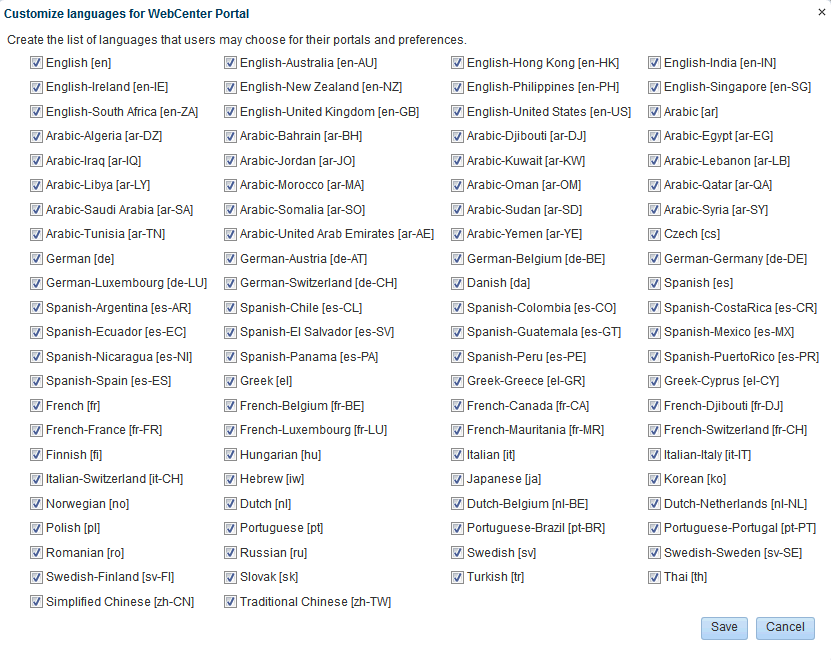
Description of "Figure 48-14 Selecting Which Languages Are Available"
-
Click Save.
48.9 Choosing a Default Start (or Landing) Page
By default, users see the Home portal when they log in, but you can configure the initial landing page to be a specific portal or page. You can specify a start page for a specific group, for authenticated users, and for public users. For more information, see the "Managing Roles and Permissions for a Portal" chapter in Oracle Fusion Middleware Building Portals with Oracle WebCenter Portal.
To select the landing page for WebCenter Portal:
-
On the Administration page (see Section 47.2, "Accessing the Portal Builder Administration Page"), click General.
You can also enter the following URL in your browser to navigate directly to the General page:
http://host:port/webcenter/portal/builder/administration/general
See Also:
"WebCenter Portal Pretty URLs" appendix in Oracle Fusion Middleware Building Portals with Oracle WebCenter Portal.
-
In the Default Portal section, select what users see first when they log in: the Home portal, or a specific portal or page (Figure 48-15).
Figure 48-15 Choosing a Default Start Page
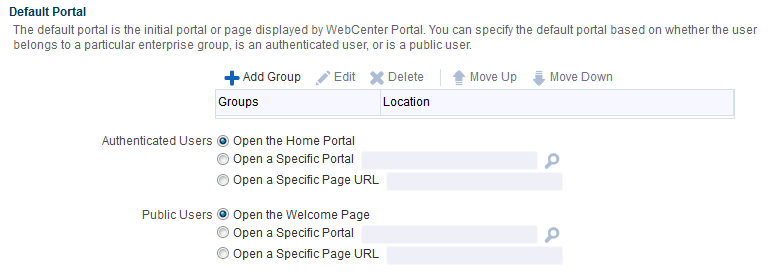
Description of "Figure 48-15 Choosing a Default Start Page"
-
To specify a default landing page for selected groups, see Section 48.9.1, "Choosing a Default Start Page for Groups."
-
To specify a default landing page for all other authenticated users who do not belong to any of the specified groups, see Section 48.9.2, "Choosing a Default Start Page for Authenticated Users."
-
To specify a default landing page for all public users, see Section 48.9.3, "Choosing a Default Start Page for Public Users."
-
-
Click Save.
48.9.1 Choosing a Default Start Page for Groups
-
On the Administration page (see Section 47.2, "Accessing the Portal Builder Administration Page"), click General.
You can also enter the following URL in your browser to navigate directly to the General page:
http://host:port/webcenter/portal/builder/administration/general
See Also:
"WebCenter Portal Pretty URLs" appendix in Oracle Fusion Middleware Building Portals with Oracle WebCenter Portal.
-
In the Default Portal section, click Add Group if you want selected enterprise groups to see a specific start page (Figure 48-15).
Note:
For the Default portal to be visible to a group member, the group itself should be a member of the portal, if the portal is hidden or private.
-
From the Add Group dialog, search for a group or select a group from the list, then click OK.
The selected group appears (Figure 48-16).
Figure 48-16 Specifying a Landing Page for a Group

Description of "Figure 48-16 Specifying a Landing Page for a Group "
Notice that the group will go to the Home portal upon logging in.
-
To change the Location of the landing page, select the group name and click Edit.
The Edit dialog appears (Figure 48-17)
-
Select whether the group will first see the Home portal, or a specific portal or page:
-
Open the Home Portal. Selected by default. Users see the Home portal when they first log in.
-
Open a Specific Portal. Select to specify that a particular portal displays, and enter the portal name or click Browse to select from a list of portals. Select an option from the Show Portals list, and click OK. For example,
http://host:port/webcenter/portal/portalName
-
Open a Specific Page URL. Select to specify that a particular page displays, and enter the page location.
Typically this is an internal page. You can enter a full or relative page URL as shown in these examples:
http://mywebcenter.com:8888/webcenter/portal/page/landingpagehttp://mywebcenter.com:8888/webcenter/portal/portalname/page/landingpage/portals/portalname/page/landingpageIf you specify an external page, make sure that you specify the full URL.
-
-
Click Save.
48.9.2 Choosing a Default Start Page for Authenticated Users
WebCenter Portal users have the default Authenticated-User role. A portal is not fully accessible until you give the Authenticated-User role permissions to access the pages of the portal. For more information, see the "Viewing and Editing Permissions for a Portal Role" section in Oracle Fusion Middleware Building Portals with Oracle WebCenter Portal.
-
On the Administration page (see Section 47.2, "Accessing the Portal Builder Administration Page"), click General.
You can also enter the following URL in your browser to navigate directly to the General page:
http://host:port/webcenter/portal/builder/administration/general
See Also:
"WebCenter Portal Pretty URLs" appendix in Oracle Fusion Middleware Building Portals with Oracle WebCenter Portal.
-
In the Authenticated Users section, specify what authenticated users, who are not in any of the groups, specified in Section 48.9.1, "Choosing a Default Start Page for Groups," see when they first log in (Figure 48-18).
Figure 48-18 Selecting a Landing Page for Authenticated Users

Description of "Figure 48-18 Selecting a Landing Page for Authenticated Users "
-
Open the Home Portal. Selected by default. Users see the Home portal when they first log in.
-
Open a Specific Portal. Select to specify that a particular portal displays, and enter the portal name For example:
http://host:port/webcenter/portal/portalName
Or click Browse to select from a list of portals (Figure 48-19). Select an option from the Add Portal list, and click OK, or enter the portal name in the Search field and click Search.
-
Open a Specific Page URL. Select to specify that a particular page displays, and enter the page location.
Typically this is an internal page. You can enter a full or relative page URL as shown in these examples:
http://mywebcenter.com:8888/webcenter/portal/page/landingpagehttp://mywebcenter.com:8888/webcenter/portal/portalname/page/landingpage/portals/portalname/page/landingpageIf you specify an external page, make sure that you specify the full URL.
-
-
Click Save.
48.9.3 Choosing a Default Start Page for Public Users
Any user with access to WebCenter Portal who is not logged in assumes the Public-User role. For more information, see the "Managing Roles and Permissions for a Portal" chapter in Oracle Fusion Middleware Building Portals with Oracle WebCenter Portal.
You can make a portal available to anyone with access to the WebCenter Portal instance that contains the portal. Registering for a WebCenter Portal account is not required. The public information provided allows the portal to be shared with non-members and people outside of the WebCenter Portal community. For more information, see the "Granting Public Access to a Portal" section in Oracle Fusion Middleware Building Portals with Oracle WebCenter Portal.
-
On the Administration page (see Section 47.2, "Accessing the Portal Builder Administration Page"), click General.
You can also enter the following URL in your browser to navigate directly to the General page:
http://host:port/webcenter/portal/builder/administration/general
See Also:
"WebCenter Portal Pretty URLs" appendix in Oracle Fusion Middleware Building Portals with Oracle WebCenter Portal.
-
In the Default Login Settings section, specify what public users see when they first log in (Figure 48-20).
Figure 48-20 Selecting a Landing Page for Public Users

Description of "Figure 48-20 Selecting a Landing Page for Public Users "
-
Open the Home Portal. Selected by default. Users see the Home portal when they first log in.
-
Open a Specific Portal. Select to specify that a particular portal displays, and enter the portal name. For example,
http://host:port/webcenter/portal/portalName
Or click Browse to select from a list of portals (Figure 48-19). Select an option from the Add Portal list, and click OK, or enter the portal name in the Search field and click Search.
-
Open a Specific Page URL. Select to specify that a particular page displays, and enter the page location.
Typically this is an internal page. You can enter a full or relative page URL as shown in these examples:
http://mywebcenter.com:8888/webcenter/portal/page/landingpagehttp://mywebcenter.com:8888/webcenter/portal/portalname/page/landingpage/portals/portalname/page/landingpageIf you specify an external page, make sure that you specify the full URL.
-
-
Click Save.
48.10 Specifying Session Timeout Settings
When there is no activity for an extended period of time in a WebCenter Portal session, it times out. Out-of-the box, the WebCenter Portal session timeout is set to 45 minutes. You can modify the default number of minutes that can elapse before a session times out, and select whether you want to display a popup or a window when the session times out.
Note:
The value for session timeout can also be seen on the Attributes page with the attribute name wcSessionTimeoutPeriod.
To modify the session timeout settings for WebCenter Portal:
-
On the Administration page (see Section 47.2, "Accessing the Portal Builder Administration Page"), click General.
You can also enter the following URL in your browser to navigate directly to the General page:
http://host:port/webcenter/portal/builder/administration/general
See Also:
"WebCenter Portal Pretty URLs" appendix in Oracle Fusion Middleware Building Portals with Oracle WebCenter Portal.
-
In the Session Timeout section, select the desired result when WebCenter Portal times out (Figure 48-21).
-
Display Timeout Page. Select to display the WebCenter Portal timeout page in the browser (Figure 48-22), where the user can click the provided link to log in again and restart at the default start page (see also Section 48.9, "Choosing a Default Start (or Landing) Page").
-
Display Timeout Popup. Select to display an Expiration Warning notification popup (Figure 48-23) when the Session Timeout value is reached. The user can click OK within 2 minutes to prevent the timeout. If the user does not respond to the Expiration Warning within 2 minutes, then the session times out. In the Timeout notification popup (Figure 48-24), the user can click OK to log in again and restart at the page that was active when the session expired.
The Display Timeout Popup option works if your browser is set to display popups. If your browser is set to block popups, then you see the timeout page.
Figure 48-23 Expiration Warning Notification (displays at Session Timeout)
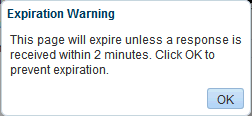
Description of "Figure 48-23 Expiration Warning Notification (displays at Session Timeout)"
Figure 48-24 Timeout Notification (displays 2 minutes after Session Timeout)
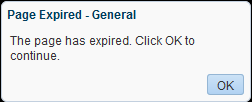
Description of "Figure 48-24 Timeout Notification (displays 2 minutes after Session Timeout)"
-
-
(Optional) In the Session Timeout (minutes) field, enter a new value.
The default value is 45 minutes, the minimum value is 5, and the maximum value is 1440 (24 hours). If this field is left blank, the default value (45) applies.
Note:
If the WebCenter Portal is configured for single sign-on (SSO), Oracle recommends that the Session Timeout value set here is no higher than the SSO timeout value. The session timeout is a factor of the physical memory available and the number of concurrent users that have to be supported. If the Session Timeout value is less than the SSO session timeout, then the WebCenter HTTP session times out after the duration specified here, but a new WebCenter session will be automatically created as long as the SSO timeout is not reached.
-
Click Save.
48.11 Enabling Self-Registration
WebCenter Portal system administrators can enable self-registration for the application. Through self-registration, invited and uninvited users can create their own login and password. A user who self-registers is immediately and automatically granted access to WebCenter Portal and a new user account is created in the identity store.
This section includes the following information:
48.11.1 About Self-Registration
Self-registration allows users to create their own login and password for WebCenter Portal. A user who self-registers is immediately and automatically granted access to WebCenter Portal and a new user account is created in WebCenter Portal's identity store.
If anyone is allowed to self-register, that is any public user, a Register link or button displays on the WebCenter Portal login page. To enable this feature, see Section 48.11.2, "Enabling Anyone to Self-Register."
Self-registration by invitation is available too. This feature allows portal moderators to send out membership invitations to people who are not currently registered with WebCenter Portal but might be interested in their portal. Before accessing the portal, invitees must create an account with WebCenter Portal and their account details are added to WebCenter Portal's identity store. If approval is required, the moderator must approve their subscription request before gaining access to the portal. If the portal is public or further approval is not required, then new user gains access to the portal immediately. See also Section 48.11.3, "Enabling Self-Registration By Invitation-Only."
Note:
If self-registration is not enabled for WebCenter Portal, identity store management takes place through the WLS Administration Console (or directly into embedded LDAP identity stores using LDAP commands) and is the responsibility of your systems administrator. See also "Section 31.3, "Adding Users to the Embedded LDAP Identity Store."
A self-registration page is supplied out-of-the-box in the System Pages page. Users with the Administrator role can add new components to the page and change the page layout if required. See Chapter 50, "Customizing System Pages."
The self-registration page provided with WebCenter Portal offers to send a "user name reminder email" to anyone who tries to register with an email address that has already been used (Figure 48-25).
Figure 48-25 Email Address Already Registered
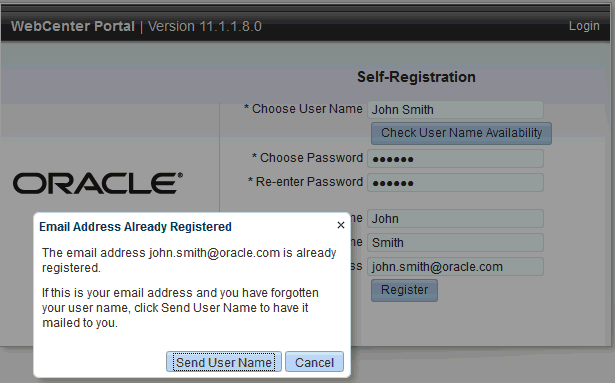
Description of "Figure 48-25 Email Address Already Registered"
This feature only works if public credentials are defined for the external application that is providing authentication for the mail service in WebCenter Portal. If users experience issues with this feature, check the mail server connection and its associated external application connection are configured correctly and that public credentials are defined. See also Section 15.4, "Registering Mail Servers."
-
For more information about setting up public credentials using Enterprise Manager, see Table 23-5, "External Application Connection - Shared User and Public User Credentials" in Chapter 23, "Managing External Applications."
-
For more information about setting up public credentials using WLST, see the "addExtAppCredential" section in Oracle WebLogic Scripting Tool.
48.11.2 Enabling Anyone to Self-Register
When anyone is allowed to self-register (that is, any public user), a Register link or button displays on the WebCenter Portal login page (Figure 48-26).
Figure 48-26 Self-Registration Available on Login Page
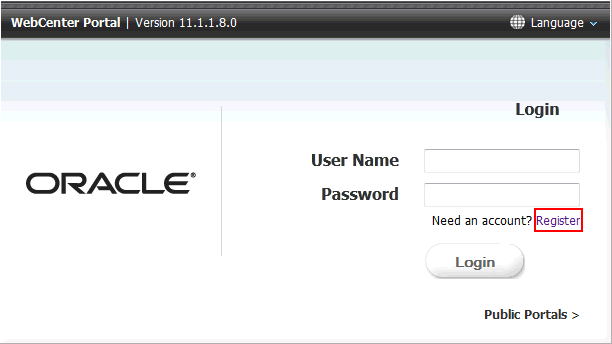
Description of "Figure 48-26 Self-Registration Available on Login Page"
New users must create an account before gaining access to WebCenter Portal.
Users who self-register are added directly to the WebCenter Portal identity store and assigned the Authenticated-User role. Out-of-the-box, users with Authenticated-User role have access to their own Home portal, pages that they create, and public pages. They are also allowed to view public portals, join any portal that allows self-subscription, and create portals of their own. If you enable self-registration, consider modifying Authenticated-User permissions to suit your exact requirements. See Section 43.4.4.2, "Modifying Application Role Permissions."
To allow anyone to self-register with WebCenter Portal:
-
On the Administration page (see Section 47.2, "Accessing the Portal Builder Administration Page"), click General.
You can also enter the following URL in your browser to navigate directly to the General page:
http://host:port/webcenter/portal/builder/administration/general
See Also:
"WebCenter Portal Pretty URLs" appendix in Oracle Fusion Middleware Building Portals with Oracle WebCenter Portal.
-
Select Allow Public Users to Self-Register (Figure 48-27).
When you deselect this option, public users cannot self-register with WebCenter Portal. You still enable self-registration on an invitation-only basis if you want. See Section 48.11.3, "Enabling Self-Registration By Invitation-Only."
Figure 48-27 Allowing Public Users to Self Register

Description of "Figure 48-27 Allowing Public Users to Self Register"
-
Click Apply.
See also the "Registering Yourself with WebCenter Portal" section in Oracle Fusion Middleware Using Oracle WebCenter Portal.
48.11.3 Enabling Self-Registration By Invitation-Only
Out-of-the-box, only registered WebCenter Portal users are candidates for portal membership. While this might meet the needs of most WebCenter Portal users, some portals will want to recruit members outside of the WebCenter Portal community.
The WebCenter Portal system administrator can extend portal membership to users outside of WebCenter Portal by allowing them to self-register on an invitation-only basis. When this facility is enabled, portal moderators can invite anyone to join their portal by sending them a customizable invitation by mail. The invitation includes a secure, self-registration URL which the invited party clicks to accept portal membership.
New members recruited in this way must create an account with WebCenter Portal before gaining access to the portal. Users who self-register by invitation are added to the identity store, and to the portal's member list.
Note:
Users who self-register by invitation will also be assigned the default application role —Authenticated-User. Out-of-the box, users with the Authenticated-User role have access to their own Home portal, pages that they create, and public pages. They are also allowed to view public portals, join any portal that allows self-subscription, and create portals of their own. When you enable self-registration, consider modifying Authenticated-User permissions to suit your exact requirements. See also Section 43.4.4.2, "Modifying Application Role Permissions."
To allow anyone to self-register with WebCenter Portal through invitations:
-
On the Administration page (see Section 47.2, "Accessing the Portal Builder Administration Page"), click General.
You can also enter the following URL in your browser to navigate directly to the General page:
http://host:port/webcenter/portal/builder/administration/general
See Also:
"WebCenter Portal Pretty URLs" appendix in Oracle Fusion Middleware Building Portals with Oracle WebCenter Portal.
-
Select Allow Self-Registration Through Invitations (Figure 48-28).
When you deselect this option, only existing users are candidates for portal membership.
Figure 48-28 Allowing Self-Registration Through Invitations

Description of "Figure 48-28 Allowing Self-Registration Through Invitations"
-
Click Apply.
After you enable this option, portal moderators can invite anyone to become a member of their portal. See the "Inviting a Non–Registered User" section in Oracle Fusion Middleware Building Portals with Oracle WebCenter Portal.
48.12 Choosing a Default Look and Feel for New Pages
Administrators can set up a default look and feel for system, business role, and personal pages to simplify page creation for first-time users or to steer users toward a particular page scheme and style.
For more information:
Individuals may personalize the default settings in their Home portal view. For more information, see Section 52.2, "Setting Application-Level Page Creation Defaults for Personal Pages."
48.13 Enabling and Disabling Access to the Home Portal
Access to the Home portal is optional—it is not mandatory to provide users with a private work area where they can store personal content and perform personal tasks. Users can fully participate in collaborative projects without access to the Home portal.
Users who do not have access to the Home portal cannot use personal productivity tools (such as favorites), create personal pages, or see personal pages that other users might share.
The Portal Server: View permission controls whether users have access to the Home portal. Administrators can disable access to everyone using WebCenter Portal or to specific users only. Use Table 48-1 to determine which permission settings are required for the different roles.
To enable or disable access to the Home portal:
-
On the Administration page (see Section 47.2, "Accessing the Portal Builder Administration Page"), click Security.
You can also enter the following URL in your browser to navigate directly to the Security page:
http://host:port/webcenter/portal/builder/administration/security
See Also:
"WebCenter Portal Pretty URLs" appendix in Oracle Fusion Middleware Building Portals with Oracle WebCenter Portal.
-
On the Roles tab, under Portal Server, select or deselect the View check boxes for the roles, as appropriate (Table 48-1):
Table 48-1 Portal Server: View Permissions
Role Select Portal Server: View Deselect Portal Server: View AdministratorUsers assigned this role can always access the Home portal.
Not applicable for administrators.
Application SpecialistUsers assigned this role can always access the Home portal.
Users with this role cannot access the Home portal. (Assumes the
Portal Server: Viewpermission is disabled for the Authenticated-User and the Public-User.)Public UserUnauthenticated users can see personal pages and content marked public.
Unauthenticated users only see the login page.
Authenticated UserEveryone can access the Home portal.
Users cannot access the Home portal unless you grant them another role that specifies otherwise.
Any Custom RoleUsers assigned the custom role have access to the Home portal.
Users with the custom role cannot access the Home portal. (Assumes the
Portal Server: Viewpermission is disabled for the Authenticated-User and the Public-User.) -
Click Apply to save your changes.
New permissions are effectively immediately.
48.14 Setting Up Defaults for WebCenter Portal Tools and Services
The system administrator is also responsible for setting up tools and services options for WebCenter Portal. For more information, see Chapter 8, "Managing Tools and Services."

